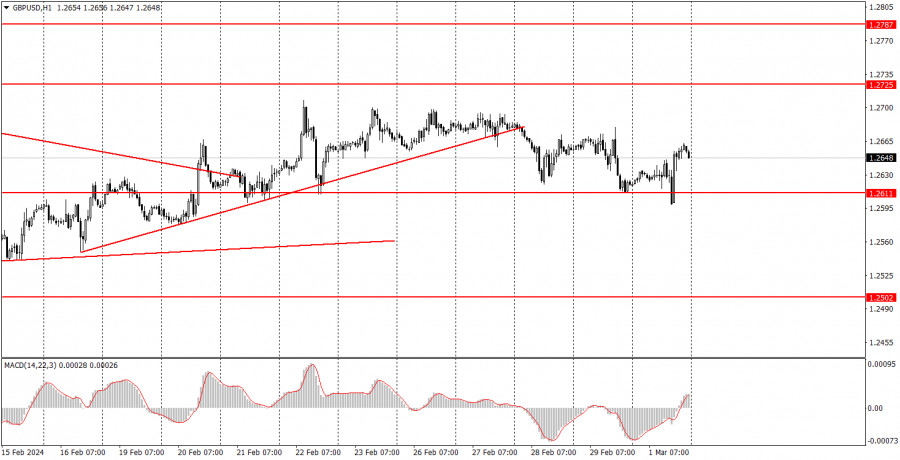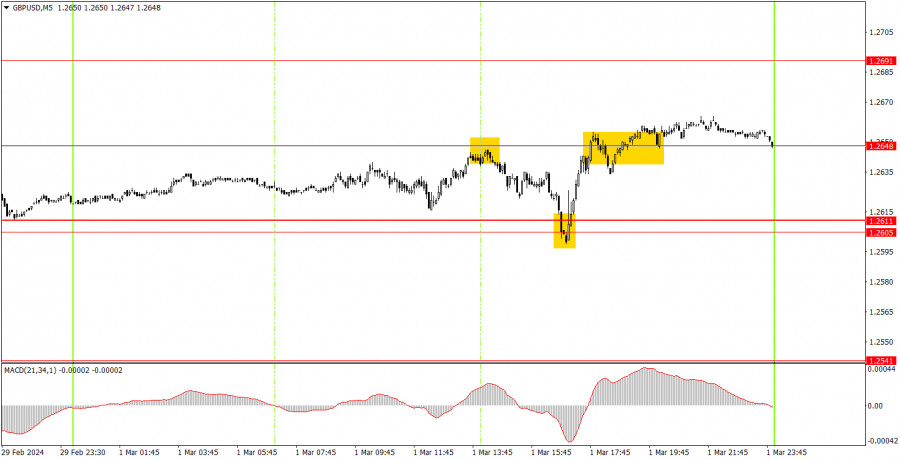

The GBP/USD pair tried to continue its downward movement on Friday but was disrupted by US macro data in the second half of the day. Two reports caught the attention of traders. The ISM Manufacturing Purchasing Managers' Index came in at 47.8, compared to the previous value of 49.1 and an expected 49.5. The University of Michigan's Consumer Sentiment Index was at 76.9 in February, also below forecasts and the previous value. Therefore, it was absolutely logical for the dollar to fall during the US session. Unfortunately, the British pound is still unable to start a new downtrend, which would have been the most natural choice, given the overall fundamental background. Often, the market simply refuses to sell the pound, but sometimes there are also days when the macroeconomic background works against the US dollar's growth.
We shouldn't expect the pair to drop until the price settles below the level of 1.2611, which has become quite notorious in recent months. If you switch to higher timeframes, you can clearly see the persistent sideways movement, which has been ongoing for several months. Therefore, the pound is also going through a flat phase, but it is more global and long-term than that of the euro.
GBP/USD on 5M chart
There were three trading signals on the 5-minute timeframe. First, a sell signal was generated around the level of 1.2648, after which the price dropped to the range of 1.2605-1.2611. Then, the price rebounded from the area of 1.2605-1.2611 and climbed back to the level of 1.2648. Eventually, the pair surpassed this level, which should also be interpreted as a buy signal. The first two trading signals could bring about 20 pips of profit, and the third signal should not have been executed as it was formed too late. The low profit is due to the pair's weak volatility.
Trading tips on Monday:On the hourly chart, GBP/USD left the sideways channel of 1.2611-1.2787 and is desperately trying to start a downtrend. However, it is not going well. We expect the pound to fall, but the market continues to trade the pair in a confusing and illogical manner. We believe it is appropriate for you to consider short positions on the pound if the pair consolidates below the area of 1.2605-1.2611. The first target is 1.2541.
The key levels on the 5M chart are 1.2270, 1.2310, 1.2372-1.2387, 1.2457, 1.2502, 1.2544, 1.2605-1.2611, 1.2648, 1.2691, 1.2725, 1.2787-1.2791, 1.2848-1.2860, 1.2913, 1.2981-1.2993. On Monday, there are no important events planned in the UK and the US, so traders will have nothing to react to. It will most likely be another boring, low-volatility day.
Basic trading rules:1) Signal strength is determined by the time taken for its formation (either a bounce or level breach). A shorter formation time indicates a stronger signal.
2) If two or more trades around a certain level are initiated based on false signals, subsequent signals from that level should be disregarded.
3) In a flat market, any currency pair can produce multiple false signals or none at all. In any case, the flat trend is not the best condition for trading.
4) Trading activities are confined between the onset of the European session and mid-way through the U.S. session, after which all open trades should be manually closed.
5) On the 30-minute timeframe, trades based on MACD signals are only advisable amidst substantial volatility and an established trend, confirmed either by a trendline or trend channel.
6) If two levels lie closely together (ranging from 5 to 15 pips apart), they should be considered as a support or resistance zone.
How to read charts:Support and Resistance price levels can serve as targets when buying or selling. You can place Take Profit levels near them.
Red lines represent channels or trend lines, depicting the current market trend and indicating the preferable trading direction.
The MACD(14,22,3) indicator, encompassing both the histogram and signal line, acts as an auxiliary tool and can also be used as a signal source.
Significant speeches and reports (always noted in the news calendar) can profoundly influence the price dynamics. Hence, trading during their release calls for heightened caution. It may be reasonable to exit the market to prevent abrupt price reversals against the prevailing trend.
Beginners should always remember that not every trade will yield profit. Establishing a clear strategy coupled with sound money management is the cornerstone of sustained trading success.